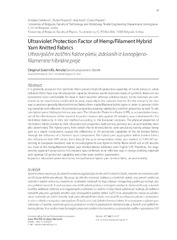Приказ основних података о документу
Ultraviolet Protection Factor of Hemp/Filament Hybrid Yarn Knitted Fabrics
| dc.creator | Stanković, Snežana | |
| dc.creator | Popović, Dušan M. | |
| dc.creator | Kocić, Ana | |
| dc.creator | Poparić, Goran B. | |
| dc.date.accessioned | 2021-03-10T13:27:48Z | |
| dc.date.available | 2021-03-10T13:27:48Z | |
| dc.date.issued | 2017 | |
| dc.identifier.issn | 0351-3386 | |
| dc.identifier.uri | http://TechnoRep.tmf.bg.ac.rs/handle/123456789/3645 | |
| dc.description.abstract | It is generally accepted that synthetic fibres provide high UV protection capability of textile products, while cellulose fibres have low UV absorption capacity. However, textile materials made of synthetic fibres are not considered to be comfortable for wear in warm weather, whereas cellulose-based textile materials are considered to be much more comfortable to wear, especially in the summer months. For this research, the idea was to produce specially blended knitted fabrics from staple/filament hybrid yarns in order to provide clothing materials with effective UV protection properties, keeping satisfactory comfort properties as well. To obtain hybrid yarns, folding technique was used. The Ultraviolet Protection Factor (UPF), as a quantitative measure of the effectiveness of the material to protect human skin against UV radiation, was determined for the rib knitted fabrics by in vitro test method according to the European standard. The physical properties of the knitted fabrics related to their UV protection properties: bulk density, porosity and air permeability were also determined. The hybrid yarns, from which the rib knitted fabrics were produced, having always hemp yarn as a staple component, caused the differences in UV protection capability of the rib knitted fabrics through the influence of a filament spun component. The hybrid yarn aggregation within knitted fabrics also influenced their UPF values. Even though the pure hemp knitted fabric was marked as "UPF gt 50" (according to European standard) due to natural pigments and lignin in hemp fibres which act as UV absorbers, most of the hemp/filament hybrid yarn knitted fabrics exhibited even higher UPF. Therefore, the engineering approach proposed in this research was confirmed as an effective way to design clothing materials with optimal UV protection capability and other wear comfort parameters. | en |
| dc.publisher | University of Ljubljani, Fac Natural Sci & Engineering, Dept Textiles, Ljubljana | |
| dc.relation | info:eu-repo/grantAgreement/MESTD/Basic Research (BR or ON)/171029/RS// | |
| dc.rights | openAccess | |
| dc.rights.uri | https://creativecommons.org/licenses/by/4.0/ | |
| dc.source | Tekstilec | |
| dc.subject | ultraviolet protection factor | en |
| dc.subject | hemp/filament hybrid yarn | en |
| dc.subject | knitted fabric | en |
| dc.subject | air permeability | en |
| dc.title | Ultraviolet Protection Factor of Hemp/Filament Hybrid Yarn Knitted Fabrics | en |
| dc.type | article | |
| dc.rights.license | BY | |
| dc.citation.epage | 57 | |
| dc.citation.issue | 1 | |
| dc.citation.other | 60(1): 49-57 | |
| dc.citation.spage | 49 | |
| dc.citation.volume | 60 | |
| dc.identifier.doi | 10.14502/Tekstilec2017.60.49-57 | |
| dc.identifier.fulltext | http://TechnoRep.tmf.bg.ac.rs/bitstream/id/9581/10.14502Tekstilec2017.60.49-57.pdf | |
| dc.identifier.scopus | 2-s2.0-85019160230 | |
| dc.identifier.wos | 000426074500006 | |
| dc.type.version | publishedVersion |

